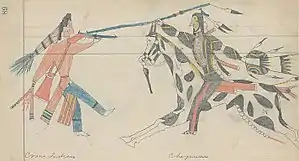Counting coup
Among the Plains Indians of North America, counting coup is the warrior tradition of winning prestige against an enemy in battle. It is one of the traditional ways of showing bravery in the face of an enemy and involves intimidating him, and, it is hoped, persuading him to admit defeat, without having to kill him. These victories may then be remembered, recorded, and recounted as part of the community's oral, written, or pictorial histories.

Historical precedents
Historically, any blow struck against the enemy counted as a coup, but the most prestigious acts included touching an enemy warrior with a hand, bow, or coup stick and escaping unharmed, and without harming the enemy, except for the enemy's wounded pride.[1][2]
Touching the first enemy to die in battle or touching the enemy's defensive works was also considered counting coup,[1] as was, in some nations, simply riding up to an enemy, touching him with a short stick, and riding away unscathed.[3] Counting coup has at times also involved stealing an enemy's weapons or horses tied up to his lodge in camp.[1] Risk of injury or death is traditionally required to count coup.[4] Escaping unharmed while counting coup is traditionally considered a higher honor than being wounded in the attempt.[1]
After a battle or exploit, the people of a band gathered to recount their acts of bravery. Coups have been recorded by putting notches in a coup stick.[1] Indigenous peoples of the Pacific Northwest traditionally tied an eagle feather to their coup sticks for each coup counted.[1] Among the Blackfoot nation of the upper Missouri River Valley, coup was recorded by the placement of "coup bars" on the sleeves and shoulders of special shirts bearing paintings of the warrior's exploits in battle. Many shirts of this sort have survived to the present, including some in European museums.[5] In some tribes, a warrior who won coup was permitted to wear an eagle feather in his hair,[1] and if wounded in the attempt, was required to paint the feather red to indicate this.[1]
Contemporary accounts
Joe Medicine Crow (1913–2016) is credited with achieving the feat while serving with the US Army during World War II, as on one occasion he overpowered and disarmed a German soldier,[6] and later stole horses from an SS unit.[7]
In the fall of 2016, activist, singer, and horseman Greg Grey Cloud (Crow Creek Nation) was on the front line blockade at the Dakota Access Pipeline protests, where Native American water protectors and their supporters were facing Dakota Access Pipeline security, local police, and police who had been brought in from other jurisdictions. Grey Cloud, on horseback in regalia and as part of a small group of people called the Spirit Riders, rode up to the police line and counted coup on the police.[8]
Medicine men first painted our horses and used medicine carried by Crazy Horse before we dressed the horses.
We counted coup on the police who were trying to keep the water protectors away. The police moved back and ran away so that the protectors could move forward and protect the land where our ancestors were buried.
Successfully counting coup disgraces your opponent. It’s a way of publicly shaming them. We believe that if you are shamed, you must admit defeat.
It’s a far more prideful and honorable way to defeat the enemy without having to kill. ~ Greg Grey Cloud[8]
References
- Plenty Coups and Linderman, Plenty-Coups, Chief of the Crows, 2002, p. 31.
- "Counting Coup. Counting What?" Antiques Roadshow, WGBH.
- Mercedes Mejía. "Campfire Stories: 'Counting coup' and a warrior's unbreakable pride" (text introduction to a broadcast story from Potawatomi elder Colin Wesaw), Michigan Public Radio, 14 August 2018.
- "COUNTING COUP". Encyclopedia of the Great Plains Indians. University of Nebraska–Lincoln, 2011.
- Brownstone, Arni. "The Musée de l'Homme's Foureau Robe and Its Moment in the History of Blackfoot Painting". Plains Anthropologist 46.177 (2001): 249–267: 255. JSTOR 25669728.
- "Joe Medicine Crow". PBS. Archived from the original on 7 April 2016. Retrieved 10 May 2021.
{{cite web}}: CS1 maint: bot: original URL status unknown (link) - "President Obama Names Medal of Freedom Recipients". whitehouse.gov (Press release). July 30, 2009. Archived from the original on January 28, 2017. Retrieved April 4, 2016 – via National Archives.
- Pember, Mary Annette (31 Aug 2017). "Horse Therapy Helping Break the Stigma of Sexual Abuse". Indian Country Today. Retrieved 3 May 2021.